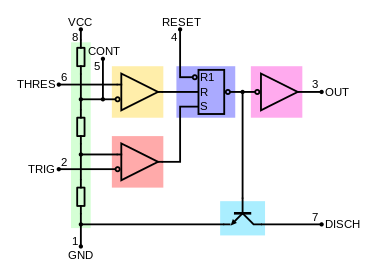Lesson 14 – Integrated Circuits

Welcome to Electronics For Fun
Lesson 14 – Integrated Circuits
As I introduce new terms, I have included a link to Wikipedia. Read ahead a little, and if you still need help, you can click on any orange word below for more information than you probably want. 🙂
What is an Integrated Circuit
A long time ago, radios and televisions were made with discrete passive components like resistors, capacitors, etc. They also used Vacuum Tubes as the active components for amplifying, etc.. When Transistors were invented, everything got a lot smaller, less expensive, used less power, and lasted a lot longer. They still needed and used the discrete passive components, just the vacuum tubes were gone and replaced with transistors. When Integrated Circuits came out, not only did the transistors get smaller, but so did the other components, the resistors, capacitors, etc.
An Integrated circuit or IC, consists of many very small electronic circuits all on the same small wafer. They are usually made of silicon and contain many electronic components arranged to function as an entire circuit rather than using descrete components like transistors, resistors, capacitors, etc. Modern ICs can contain millions and even billions of components.
The cost to design them is very expensive, however, once they are designed, the cost to manufacture them is fairly inexpensive. So as long as the manufacturer feels that they will sell a large amount of a particular IC, they will proceed with the design and making them.
There are four main advantages of ICs over individual components like resistors, capacitors, transistors, etc. First, once the design work is finished, the actual circuits are “printed” on the wafer using a process called photolithography. Making ICs this way is not only less expensive than making those individual components as far as the process goes, but there is much less cost for materials because of the smaller size.
That brings me to the second advantage, size. Because the transistors, resistors, etc, are so tiny, so are the products that they are used in. The third advantage is related to the smaller size again. Because the circuits are so close together, the signals don’t have as far to travel, and because of that they are also much faster. The fourth advantage is they use much less power which results in less weight and longer lasting batteries.
I’m pretty sure you all know how small cell phones are today. The first hand held cellular phone was rather large as you can see in the photo below. It was first demonstrated to the public on April 3, 1973 by its inventor Martin Cooper. No screen, no pictures, no Internet, and it weighed over 2 pounds!

Let me tell you a little story about I saw integrated circuits reducing size while increasing the performance of memory. In the computer world, here is an example, not from the Internet, but from when I worked for IBM. First of all, before I tell you this little story, let me point out that my Grandson’s iPhone he currently owns, has 128GB or 128 gigabytes of memory, or 128 billion bytes.
A byte is 8 bits plus a parity bit of information representing some data. It might be a letter, like a thru z, a single digit of a phone number, or part of an address. Anyhow, at about the same time as when that first cell phone came out in 1973, the customer I was assigned to, installed an IBM System 370 Model 158 mainframe. It had a large physical “footprint” meaning it took up quite a bit of space in a “computer room”. It had a whopping 1MB of memory, in other words 1 megabyte, that’s 1 million bytes.
Less than two years later in 1975, the customer needed more physical memory in their computer system. I upgraded that same IBM 370 to its maximum of 2MB. The cost for the additional 1 million bytes, was just over a million dollars! That was a dollar a byte! Remember now, my Grandsons phone has 128GB! That’s 128 billion bytes, and fits in his pocket! That’s the end of my maybe boring personal story, I just wanted to show how integrated circuits have reduced cost, size, and speed by an incredible amount.
When I first started playing around with ICs, most of them were small TTL 14 pin DIPs, also called DILs..
WHAT THE HECK??
OK, they were Dual-In-Line ICs, with 2 rows of 7 pins, in the Transistor – Transistor – Logic family. Here is a picture.

TTL was just one of the many different ways of manufacturing and methods of coupling the different stages together. I wouldn’t concern yourself too much with the history although a lot of those chips are actually still available today, but most have been replaced with CMOS or MOS chips. You can find more information on the different Logic Families at Wikipedia if you have trouble sleeping at night, but the main thing to know is that they all have many thousands, millions, and some even billions of tiny circuits inside.
That one little chip below is a Quad Bilateral Switch. That means it has 4 complete separate circuits, each one is a switch controlled by a logic input pin. Below is a block diagram and pinout or diagram of what each pin is hooked to internally. Let’s take the top block labeled A1 for example. The high or low logic voltage applied to pin 13, the enable pin, is used to control whether pin 1 is logically hooked to pin 2 or not. A2 thru A4 work the same way so there are actually 4 complete sets on that one little chip.

I don’t know how many actual transistors are inside that little chip, but according to wikipedia, as of 2020, the highest transistor count in a currently manufactured IC is Nvidia’s GA100 Graphics Processing Unit with 54 billion MOSFETs!
My absolute favorite Integrated Circuit of all time is not from 2020, it’s from 1972! It’s a little 8 pin Dual-Inline-Package IC that It can be used for so many things it’s almost unbelievable. It can be used as a timer, a delay circuit, a pulse generator, an oscillator, and many more things. It’s the NE555 IC, and I will be doing a separate video on it in the FUN section.


Test your knowledge if you feel like it with a little test. No cheating now!
Q1: Resistors, Capacitors, and Inductors are _____________ components.
Q2: Which of the following statements are true about an IC?
- They weigh less than discrete components.
- The cost to manufacture them is very expensive.
- They use more power than discrete components
Q3: Which of the following statements are true about an IC?
- All Integrated Circuits in DIP packages have 14 pins.
- All ICs in DIP packages have 2 rows of pins.
- Some Integrated Circuits in DIP packages have 7 pins.

©2020 ElectronicsForFun.Com, Theme Design by Evolve Themes and Proudly Powered by WordPress